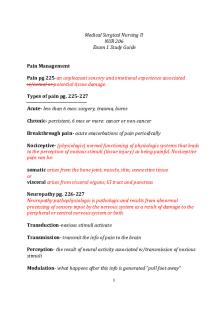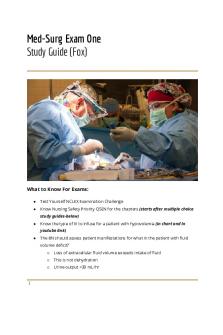Med Surg 1 Exam 2 Study Guidelines 2021 PDF

| Title | Med Surg 1 Exam 2 Study Guidelines 2021 |
|---|---|
| Course | Med Surg |
| Institution | Fortis College |
| Pages | 26 |
| File Size | 200.1 KB |
| File Type | |
| Total Downloads | 34 |
| Total Views | 141 |
Summary
Study guidelines for 201 Med surg will help with exam 2 and ABGs....hope this helps someone!...
Description
Med Surg I Study Guide (Exam 2) CHAPTER 14: INFECTION 1. Understand the impact of emerging infections and re-emerging infections on health care. Emerging Infections (Types: Table 14.4, pg 213) Infectious Disease that has Recently Increased in Incidence (or Threatens to Increase in the Immediate Future) Reemerging Infections (Types: Table 14.5, pg 214) Infectious Agents that can Reemerge Under the Right Conditions 2. Relate infection prevention to the nursing process: assessment, diagnosis, planning, implementation, and evaluation. Infection Prevention Assessment o DO NOT Make Assumptions About WHO May be At Risk Ex. Elderly, Sexual Preference (Ex. Hetero), Married o Candid Conversation is Important for Effective Management of HIV o Ask At-Risk Patients (Have You Ever…) Had a Blood Transfusion or Used Clotting Factors? o If So, Was it Before 1985? Shared Drug-Using Equipment with Another Person? Had Sex Involving Contact with Another Person? Had a Sexually Transmitted Infection [STI]? Had Sex Involving Confirmed HIV Patient? o Assess Diagnosed Patients Thoroughly (Table 14.15, pg 223) Past Health History Medications (Immunosuppressive Use) Functional Health Patterns Presence of Symptoms Using a Systems Review Diagnosis o Nursing Diagnosis for HIV Risk for Infection Lack of Knowledge Difficulty Coping Impaired Nutritional Status o Diagnostic Studies Screening Tests (Detects HIV-Specific Antibodies/Antigens) o Several Weeks to Detect Antibodies (Window Period) o Uses Blood/Saliva o Combination Antigen-Antibody Tests (Detects HIV Earlier)
HIV Progression Monitoring o CD4 Cell Count Provides a Marker of Immune Function o Viral Load o Lower Vital Load = Less Active Disease Abnormal Blood Tests are Common o Caused by: HIV, Opportunistic Diseases, Complications of Therapy Decreased WBC Counts o Especially Lymphopenia and Neutropenia Low Platelet Counts (Thrombocytopenia) Anemia (Associated with Antiretroviral Therapy [ART] Altered Liver Function Resistance Tests Helps Determine Patient’s Resistance to ART Assays [Analysis] Helps HCPs Know Which Med May be Effective o Genotype/Phenotype Assay Planning o Goals for Care Adherence with Drug Regimens Adopting a Healthy Lifestyle o Includes Avoiding STI and Blood-Borne Illnesses Protecting Others from HIV Beneficial Relationships Explore Spiritual Issues Maintain Activities and Productivity Accepting Issues Related to Disease/Disability/Death Coping with the Disease and Its Treatment Implementation o Primary Prevention + Health Promotion MOST Effective Strategies for Chronic Diseases (Ex. HIV) o Failed Prevention = Disease Results Early Intervention is Facilitated by Health Promotion Practices Evaluation o Expected Outcomes of Patient AT RISK for HIV Develop/Implement Personal Plan to Decrease Personal Risk Factor Have HIV Testing o Expected Outcomes of Patient WITH HIV Adhere to Treatment for HIV Disease Work with the Health Care Team to Achieve Optimal Health Prevent Transmission of HIV to Others
3. Understand the HAI’s and methods to reduce them. Health Care-Acquired Infections [HAIs] Infections Acquired from Exposure in a Health Care Setting Methods for Reducing HAIs Use PPE (Gloves, Gowns, Masks, Goggles, Face Shields) Hand Washing (Alcohol, Soap + Water) Decontamination of Equipment 4. Explain the transmission of HIV and risk factors for infection. HIV Transmission Transmits Through Contact with Certain Body Fluids o Blood, Semen, Vaginal Secretions, Breast Milk NOT Spread Through Casual Contact o Hugging, Dry Kissing, Shaking Hands, Sharing Utensils, Toilet Seats Unprotected Sex with HIV-Infected Partner (MOST Common) o Greatest Risk: Partner Receiving Semen Prolonged Contact with Infected Fluids Women at Higher Risk Trauma Increases Likelihood of Transmission Contact with Blood o Drug-Using Paraphernalia is Highly Risky o Puncture Wounds (Most Common Work-Related HIV Transmission) o Blood Transfusions (However, Routine Screenings Have Improved) Perinatal Transmission o Can Occurring During Pregnancy, Delivery, or Breastfeeding o 25% of Infants Born to Untreated HIV Mothers will Be Born with Infection ART Treatment Can Reduce Rate to Less than 2% 5. Explain the teaching involved in HIV prevention and control. HIV Prevention/Control Increase Safer Sexual Practices o Abstinence o Limit Contact Activities Involving the Mouth, Penis, Vagina, Rectum o Use Barriers (Ex. Condoms) o Educate/Counsel About Preexposure Prophylaxis [PrEP] Decreasing Risks: Drug Use o DO NOT… Use Drugs Share Equipment Have Sex Under the Influence of Any Impairing Substance
o Refer for Help with Substance Use
Decreasing Risks: Perinatal Transmission o Prevent HIV in Women (Most Susceptible; Potential to Affect Infant) o Family Planning (Options of ART Use to Decrease Transmission) Decreasing Risks: Work o Adhere to Precautions/Safety Measures to Avoid Exposure o Report All Exposures for Timely Treatment and Counseling o Postexposure Prophylaxis [PEP] + ART Can SIGNIFICANTLY Decrease Risk of Infection 6. Apply how HIV and AIDS is diagnosed. Diagnosing HIV Testing (ONLY Sure Method of Determining HIV Infection) o Universal, Voluntary Testing as Part as Routine Medical Care o 14% of People with HIV are Not Aware of Being Infected Diagnosing AIDS (CDC Criteria Must Be Met for HIV Patient) CD4+ T Cell Count: BELOW 200 Cells/uL o NORMAL: 800 – 1200 Cells/uL (HIV: Below 500 Cells/uL) One of the Following Opportunistic Infections [OIs] o Bacterial, Fungal, Protozoal, Viral (Table 14.10, pg 219) One of the Following Opportunistic Cancers (Same Table) Wasting Syndrome (Loss of 10% or More of Ideal Body Mass) 7. Apply testing for HIV to patient education and care. Include Testing for HIV When Caring/Educating Patients 8. Understand the role of antiretroviral therapy and the side effects that occur. Antiretroviral Therapy [ART] Combination of Medications Used to Control/Suppress HIV Replication Reduces Risk for Transmission (Especially for Pregnant Women Neonate) ART Side Effects Lipodystrophy (Changes in Body Shape) o Fat is Redistributed into the Abdomen, Upper Back, and Breasts o Fat Loss Occurs in the Arms, Legs, and Face Hyperlipidemia o High Triglycerides, Increased Low Density Lipoproteins [LDL] o Decreased High Density Lipoproteins [HDL] Insulin Resistance Hyperglycemia Bone Disease (Osteoporosis, Osteopenia, Avascular Necrosis) Lactic Acidosis
Renal Disease Cardiovascular Disease 9. Explain the role of PrEP. Preexposure Prophylaxis [PrEP] Comprehensive HIV Prevention Strategy to Reduce Chances of Acquiring HIV Infection in Individuals at Risk Currently Involves Daily HIV Antiretrovirals Used in Conjunction with Other Proven Prevention Interventions Tenofovir Disoproxil Fumarate [TDF] + Emtricitabine (First Approved PrEP) o Effective/Safe Therapy for Preventing HIV Transmission o Prescription is Increased for Patients at Risk of Acquiring HIV Increased Prescription Potentially Reduces New HIV Infections 10. Apply the risks of opportunistic diseases to patient with HIV infection. Opportunistic Diseases Infections/Cancers that Occur in Immunosuppressed Patients Main Cause of Disease, Disability, and Death in HIV Patients 11. Describe the onset and sequelae of HIV infection. HIV Infection Onset (Acute Infection)(2 – 4 Weeks After Infection) o Immune Problems Start when CD4+ T Cells Drop Drops Below 500 Cells/uL SEVERE Problems Occur when Less than 200 Cells/uL o Mononucleosis-Like Symptoms Fever, Swollen Lymph Nodes Sore Throat, Headache, Malaise, Nausea Muscle/Joint Pain, Diarrhea, Diffuse Rash o HIGHLY INFECTIOUS Sequelae (Pathological Condition Resulting from a Prior Disease/Illness/Attack) o Asymptomatic Infection (No Signs/Limited Signs of Infection) AIDS [Acquired-Immunodeficiency Syndrome] o Can Develop in 10 Years if HIV is Left Untreated o Symptomatic Infections (Signs of Infection are Visible) CD4+ T Cells DECLINE Closer to 200 Cells/uL o HIV Advances to a More Active Stage o Symptoms Worsen Persistent Fever Frequent Night Sweats Chronic Diarrhea Recurrent Headaches Severe Fatigue
Oropharyngeal Candidiasis [Thrush] o MOST Common Infection Associated with HIV
12. Describe palliative care. (pg 127) Palliative Care Any Form of Care/Treatment that Focuses on Reducing the Severity of Disease Symptoms GOALS of Palliative Care o Prevent/Relieve Suffering o Improve Quality of Life for Patients with Serious Life-Threatening Illnesses
CHAPTER 15: CANCER 13. Understand the basic etiology of cancer: mutated body cells. Cancer (Diseases Characterized by Uncontrollable/Unregulated Growth of Cells) Mutated Body Cells are the Basic Etiology of Cancer 14. Describe the role of the immune system in promoting and preventing cancer. Role of the Immune System (Related to Promoting/Preventing Cancer) Immune Response: To Reject/Destroy Cancer Cells o Inadequate IF Cancer Cells Arise from Normal Human Cells o Some Cancer Cells Can Change the Antigens on Their Surfaces Tumor-Associated Antigens [TAAs] Immunologic Surveillance (Response to Removing TAAs) o Lymphocytes Continually Check Cell Surface Antigens Detects/Destroys Abnormal Cells o Involves Cytotoxic T Cells, Natural Kill Cells, Macrophages, and B Cells Cytotoxic T Cells (Dominant Role in Resisting Tumor Growth) o Kills Tumor Cells/Produces Cytokines [Interleukin-2 [IL-2]; y-Interferon] Stimulates T Cells, NK Cells, B Cells, Macrophages o Leads to Increased Cytotoxic Activity Natural Killer [NK] Cells o Kills Tumor Cells DIRECTLY WITHOUT Prior Sensitization B Cells o Produces Antibodies that Bind to Tumor Cells Immunologic Escape (Mechanisms Cancer Cells Utilize to Evade the Immune System) Suppression of Factors that Stimulate T Cells Weak Surface Antigens (Allows Cancer Cells to “Sneak Through” Surveillance) Develops Tolerance to Immune System Secretion of Products that Suppress the Immune System Induction of Suppressor T Cells Blocks Antibodies from Binding with TAAs (Prevents Recognition) Oncofetal Antigens [“Tumor Markers”] (Type of Tumor Antigen)
Can Be Used to Monitor Effects of Therapy and Indicate Tumor Recurrence o Not 100% Specific for Tumor Recurrence (Has Various Factors) Found on Tumor Cell Surfaces, Inside Tumor Cells and Fetal Cells Cell Could Regain Embryonic Capability to Differentiate into Many Cell Types 15. Relate the nurse’s role to prevention, treatment, and diagnosis of cancer. Nursing Role (Prevention of Cancer) General Education Goals (Prevention is KEY) o Motivate People to Recognize/Modify Behaviors that Negatively Impact Health o Encourage Awareness of/Participation in Health-Promoting Behaviors SEVEN Warning Signs of Cancer (CAUTION) o Change in Bowel Habits o A Sore that Does Not Heal o Unusual Bleeding or Discharge from Body Orifice o Thickening or a Lump in the Breast or Elsewhere o Indigestion or Difficulty in Swallowing o Obvious Change in a Wart or Mole o Nagging Cough or Hoarseness Nursing Role (Treatment of Cancer) Factors of Treating Cancer o Tumor Histology/Staging Outcomes (PRIMARY FACTORS) o Patient’s Physiologic Status (Ex. Presence of Co-Morbid Illnesses) o Personal Desires (Ex. Active Treatment vs Palliation of Symptoms) Factors Influence… o Modalities [Types] of Treatment Surgery, Radiation, Chemo, Immuno, Targeted, Hormone o How Therapies Are Sequenced Multimodality Therapy [Combined Modality Therapy] o Length of Time that Treatment is Prescribed GOALS of Treatment o Cure (Expected to Have Greatest Chance of Eradiating Cancer) Surgery Alone OR Adjunctive Systemic Therapy o Control (Cancer is NOT COMPLETELY Eradicated But are Responsive to Anticancer Therapies) o Palliation (Relief/Control SYMPTOMS; Maintaining Quality of Life) Nursing Role (Somebody Diagnosed with Cancer) Patient May Experience Fear/Anxiety o Actively Listen to Patient’s Concerns o Manage Your Own Discomfort o Give Clear Explanations (Repeat if Necessary) o Give Written Info for Reinforcement
o Refer to Oncology Team when Possible
16. Compare and contrast the different therapies for cancer: Chemo, radiation, immunotherapies, targeted therapies, hormone and HGF therapies, and HSCT. Chemotherapy [Antineoplastic Therapy] Use of Chemicals as a Systemic Therapy for Cancer Best Therapy for Most Solid Tumors and Hematologic Cancers Can Offer Cure, Control, and (Sometimes) Palliative Care Radiation Therapy Oldest Nonsurgical Methods of Cancer Treatment More Accurate, Less Invasive Different Types of Ionizing Radiation are Used to Treat Cancer 50% of Cancer Patients Receive This at Some Point in Their Treatment Radiation (Emission of Energy and Travels Through Space/Materials Immunotherapy [Biologic Therapy] Uses the Immune System to Fight Cancer Boost/Manipulates Immune System Creates Environment Not Possible for Cancer Cells to Grow Attacks Cancer Cells Directly Targeted Therapies (Inhibitors and Antibodies) Targets Specific Cell Receptors/Pathways of Tumors o Interferes with Cancer Growth Does Less Damage to Normal Cells Agents that Target Specific Oncogenes are Being Developed Cancer CAN Become RESISTANT to Targeted Therapy o Targeted Therapy is Best Used in Combination with Chemotherapy Hormone Therapy Sex Hormones o Can Stop Growth of Cancer Cells Corticosteroids o Used in Combination with Drug Regimens Helps Curb Side Effects Hematopoietic Growth Factors [HGF] Used to Support Cancer Patients Through the Treatment of the Disease Use of this Raises SAFETY CONCERNS o Increases Risk for Death o Increases Risk for Serious Cardiovascular Events Hemoglobin Greater than 12 g/dL Hematopoietic Stem Cell Transplantation [HSGT]
Effective, Life-Saving Procedure for a Number of Malignant/Nonmalignant Diseases Allows for the Safe Use of Very High Doses of Chemotherapy/Radiation in Patients whose Tumors have Developed Resistance o Also Includes Those Who Failed to Respond to Chemo/Radiation 17. Select the nursing care for complications and side effects of cancer treatment. Nursing Care for Complications/Side Effects of Cancer Treatment Bone Marrow Suppression [BMS] o Myelosuppression (MOST Common Side Effect) o Treatment-Induced Reduction in RBCs and WBCs Results in Infection, Hemorrhaging, and Overwhelming Fatigue o Nursing Interventions for BMS Monitor CBC (Neutrophils, Platelets, RBC Counts) Wash Hands Frequently (Patient is Neutropenic) Monitor Temp Frequently (Increased Temp = Infection/Fever) Avoid Invasive Procedures (Thrombocytopenia [Low Platelets]) Fatigue o Encourage Conservation Strategies Rest Before Activity Get Assistance with Activity Remain Active During Periods of Time Patient Feels Better o Maintain Nutritional/Hydration Status o Assess for Reversible Causes of Fatigue o Causes of Fatigue Anemia Accumulation of Toxic Substances from Treatment Need for Extra Energy for Repair/Healing After Treatment Lack of Sleep Caused by Treatment (Chemo Drugs) GI Problems o Prophylactic Administration of Antiemetics o Assess for Signs/Symptoms of… Alkalosis (High Alkalinity of Blood – Excessive Bicarbonate) Dehydration Input/Output o Nonirritating, Low Fiber, High-Calorie, High-Protein Diet o Teach Importance of Oral Examination and Maintain Oral Care o Anorexia Monitor Carefully to Avoid Weight Loss (Weight 2x/Day) Recommend Small, Frequent, High-Protein, High Calorie Meals Involve Dietitian Before Treatment Begins
Integumentary/Mucosal Reactions o Lubricate Dry Skin with a Nonirritating Lotion Emollient (Aloe Vera) No Metal, Alcohol, Perfume, Irritating Additives o Wet Desquamation (Rate: Cell Sloughing > New Epidermal Cells) Exposure of Dermis; Weeping of Serous Fluids o Skin Reactions Prevent Infection Facilitate Wound Healing Protect Irritated Skin Temperature Extremes Avoid Constricting Garments, Harsh Chemicals, Deodorants Help Patient Deal with Hair Loss [Alopecia] Do NOT Use Heating/Ice Pads in Treatment Field Pulmonary Effects o Damage from Treatment Can be Irreversible and Progressive o Cough, Dyspnea, Pneumonitis, Pulmonary Edema can Occur o Methods for Treating Pulmonary Effects Bronchodilators Expectorants/Cough Suppressants Bed Rest Oxygen Cardiovascular Effects o Preexisting Coronary Artery Disease = Increased Vulnerability o Baseline/Periodic ECGs of Left Ventricular Function are Performed o CAUTION: Anthracyclines Can Cause Cardiotoxicity Cognitive Effects o Chemo Brain (Mental Cloudiness/Fog After Treatment) Can Last a Short Time OR Years Can Be Severe Reproductive Effects o Sexual Side Effects Can Occur (Ex. Sterilization) o Use Appropriate Shielding Over Reproductive Organs o Unlike Testes, there is NO WAY to Repair Ovarian Function 18. Provide therapeutic communication to help patients and significant others cope with the diagnosis and treatment of cancer. Therapeutic Communication
Encourage Patient to Share Meaning of Their Experiences Actively Listen to Patient’s Concerns Manage Your Own Discomfort Give Clear Explanations (Repeat if Necessary) Give Written Information for Reinforcement Refer to Oncology Team when Possible 19. Understand the precautions for staff, visitors, and patients in regard to brachytherapy and chemotherapy. Brachytherapy [Internal Radiation] Implantation/Insertion of Radioactive Materials Into/Close to Tumor Patient Emits Radioactivity Limit Time Near Patient Precautions with Chemotherapy ONLY Trained Personal Should Handle Cancer Drugs o Drug Can be Absorbed Through Skin and Inhalation Side Effects Occur as a Result of Destruction of Normal Cells o Leads to Increased Risk for Bleeding and Infection 20. Describe normal/abnormal lab values. Normal Lab Values WBC o 4000 – 11000 WBC/mcL RBC o Men: 4.7 – 6.1 Million Cells/mcL o Women: 4.2 – 5.4 Million Cells/mcL Platelets o 150,000 – 400,000 Platelets/mcL Hemoglobin o Men: 13.5 – 17.5 grams/dL o Women: 12 – 15.5 grams/dL Hematocrit o Men: 38.3% – 48.6% o Women: 35.5% – 44.9% 21. Understand the cause of abnormal lab values. Bone Marrow Suppression (Infection, Hemorrhage, Overwhelming Fatigue) Nadir (Lowest Blood Cell Count – Occurs 7 – 10 Days After Starting Treatment) Chemotherapy/Radiation 22. Summarize the oral chemo agents. Oral Chemo Agents More Available Options
Storage and Side Effects are Taught to Patient
23. Discuss the TNM Classification System and Clinical Stages TNM Classification System Used to Determine the Anatomic Extent of the Disease Involvement o Involves 3 Parameters Tumor Size and Invasiveness [T] Presence/Absence of Regional Spread to the Lymph Nodes [N] Metastasis to Distant Organ Sites [M] Primary Tumor [T] T0: No Evidence of Primary Tumor Tis: Carcinoma in situ [CIS] (Localized Cancer Cells; No Tendency to Spread) T1 – 4: Ascending Degrees of Increase in Tumor Size/Involvement Tx: Tumor Cannot Be Measured or Found Regional Lymph Nodes [N] N0: No Evidence of Disease in Lymph Nodes N1 – 4: Ascending Degrees of Nodal Involvement Nx: Regional Lymph Nodes Unable to Be Assessed Clinically Distant Metastases [M] M0: No Evidence of Distant Metastases M1 – 4: Ascending Degrees of Metastases Involvement (Including Distant Nodes) Mx: Cannot Be Determined Clinical Staging Stage 0: Cancer in situ Stage 1: Tumor Limited to the Tissue of Origin; Localized Tumor Stage 2: Limited Localized Spread Stage 3: Extensive Local and Regional Spread Stage 4: Metastasis
CHAPTER 29/30: HEMATOLOGIC SYSTEM/PROBLEMS 24. Know the age-related changes in the hematologic system. Age-Related Changes (Hematologic System) Caused by Cell Loss and Organ Atrophy Decreased… o Bone Marrow Mass/Cellularity o Hematopoietic Tissue in the Marrow Space o Hemoglobin Levels o Lymphocyte Function o Ability to Recover from Acute Illnesses o Ability to Compensate for Chronic Diseases o Ability to Respond to Hemorrhage/Hypoxemia Increased… o Bone Marrow Fat o Platelet Adhesiveness o Osmotic F...
Similar Free PDFs
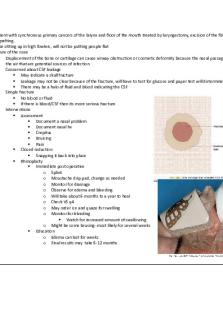
Med Surg II - Exam 2 Study Guide
- 57 Pages

Med Surg 2 Exam 3 Study Guide
- 22 Pages

Med surg exam 1 study guide
- 25 Pages
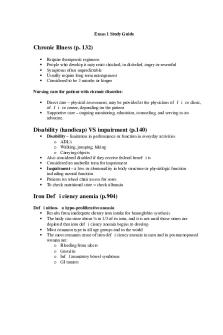
Exam 1 Study Guide - Med-Surg
- 26 Pages
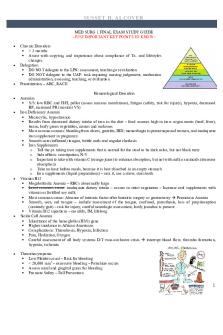
MED SURG 1 Final EXAM Study Guide
- 10 Pages

MED SURG EXAM 3-2
- 54 Pages

Med Surg Exam 3
- 19 Pages

Exam 2 Med Surg 2 Practice Questions
- 16 Pages

Med surg exam 3 study guide
- 68 Pages
Popular Institutions
- Tinajero National High School - Annex
- Politeknik Caltex Riau
- Yokohama City University
- SGT University
- University of Al-Qadisiyah
- Divine Word College of Vigan
- Techniek College Rotterdam
- Universidade de Santiago
- Universiti Teknologi MARA Cawangan Johor Kampus Pasir Gudang
- Poltekkes Kemenkes Yogyakarta
- Baguio City National High School
- Colegio san marcos
- preparatoria uno
- Centro de Bachillerato Tecnológico Industrial y de Servicios No. 107
- Dalian Maritime University
- Quang Trung Secondary School
- Colegio Tecnológico en Informática
- Corporación Regional de Educación Superior
- Grupo CEDVA
- Dar Al Uloom University
- Centro de Estudios Preuniversitarios de la Universidad Nacional de Ingeniería
- 上智大学
- Aakash International School, Nuna Majara
- San Felipe Neri Catholic School
- Kang Chiao International School - New Taipei City
- Misamis Occidental National High School
- Institución Educativa Escuela Normal Juan Ladrilleros
- Kolehiyo ng Pantukan
- Batanes State College
- Instituto Continental
- Sekolah Menengah Kejuruan Kesehatan Kaltara (Tarakan)
- Colegio de La Inmaculada Concepcion - Cebu




